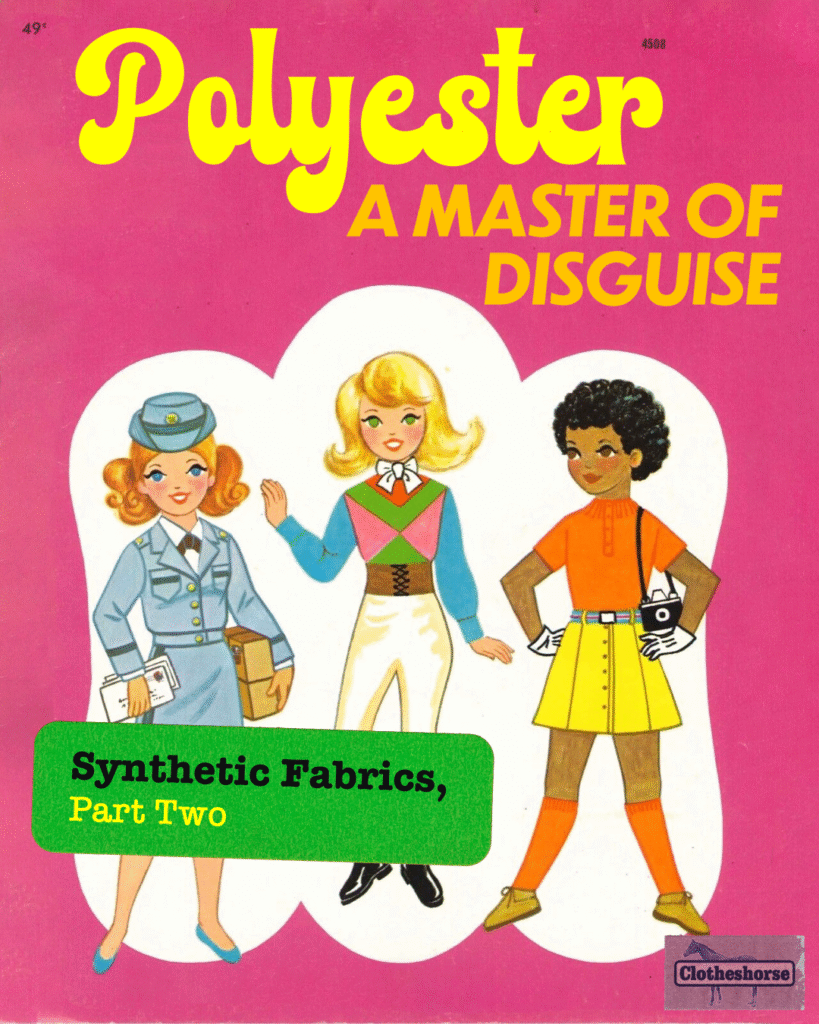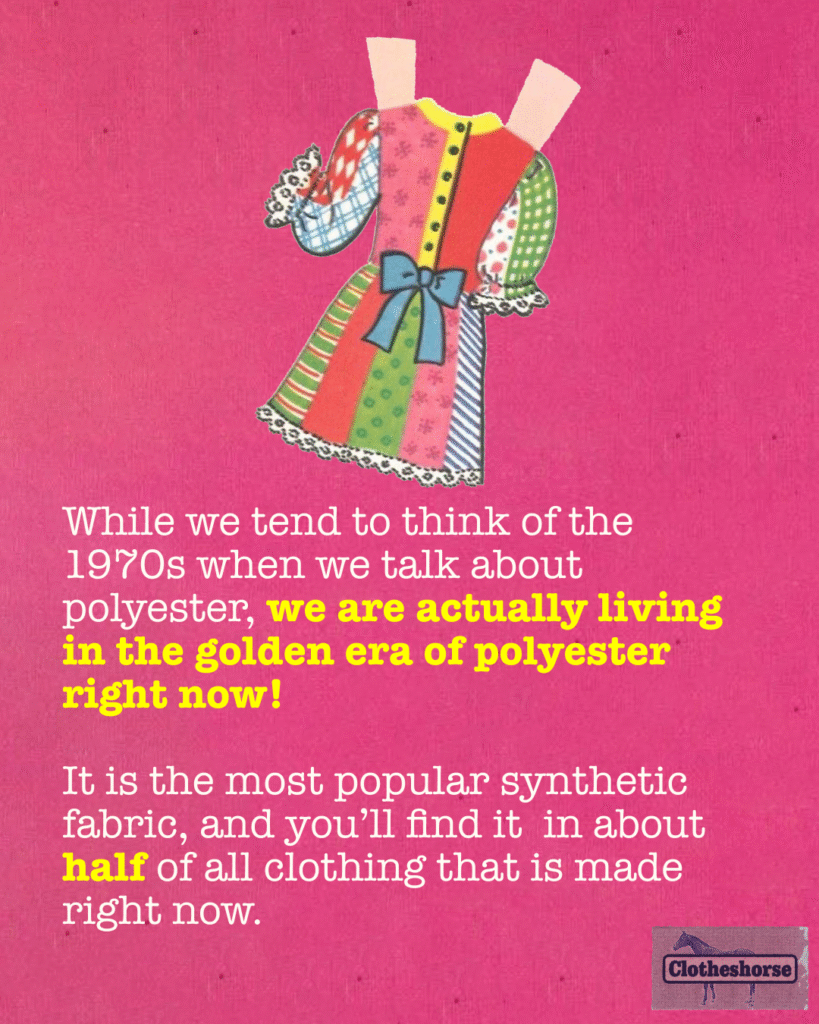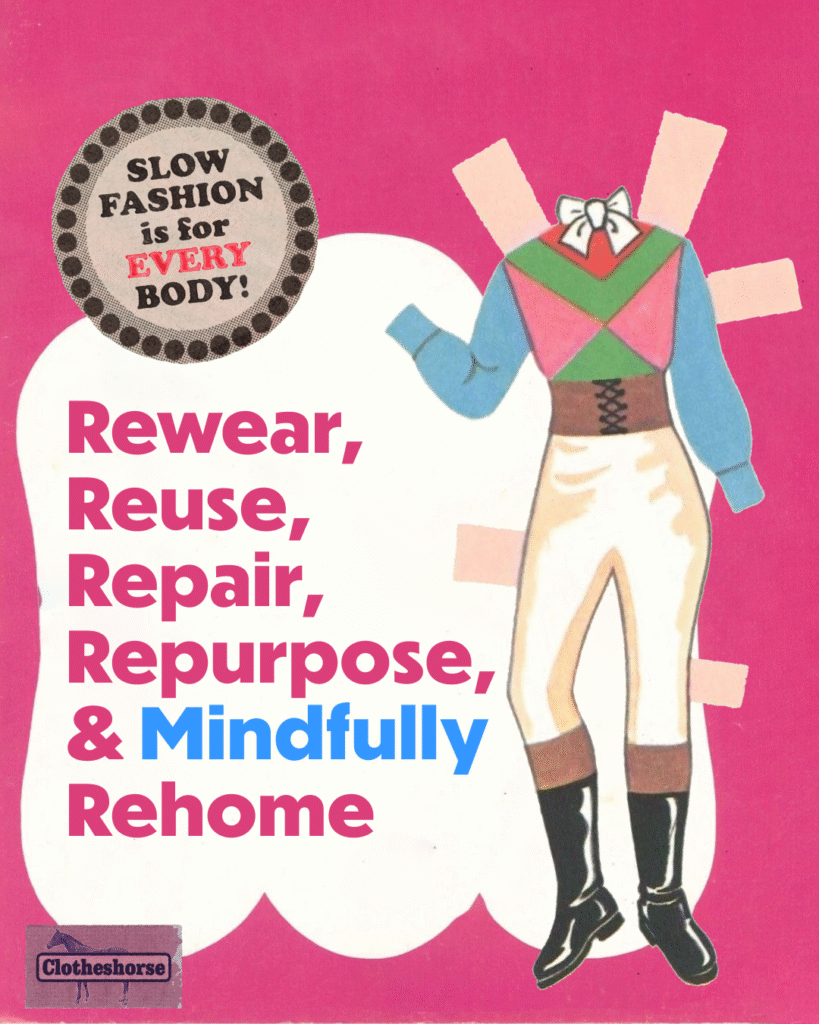
This is part two in a series. You can find part one here.
As you read the posts in this series, keep this mind:
❊ Don’t shame others (or yourself) for owning synthetic clothing. The majority of clothing made in the past ten years (or more) has been synthetic. I own clothing made from synthetic fabrics! And I’m committed to getting us much use out of those items, even buying them secondhand. I do my best to mitigate microplastic shedding by following the laundry instructions in part one of this series. And I care and repair for everything so it will last as long as possible. These items will be on this planet long after I am gone, so I want to get maximum use out of them.
❊ There is no easy answer here. Wait until we get to the natural fiber part of the series…there are lots of pesticides, water use, and greenwashing at play with natural fibers. And they may not be biodegradable either, thanks to dyes and treatments. The truth is: There is no miracle fabric that allows us to continue to overconsume clothing with no repercussion. All fabrics have an impact and we should not be overshopping. Period.
The “easiest” answer to question “which fabric is best?” is this: buy less, make it last for as long as possible, and choose fabrics/clothes that you will wear often and for a long time.
In part 2, I break down the ultimate master of disguise, polyester! We tend to think of the 1970s as the golden era of polyester: classic Mr. Furley leisure suits, separates like vests with matching pants, dresses in bold prints…but guess what? We’re using more polyester now than we did back then! Thanks to lots of innovations in polyester production, it can take on many super sneaky forms. You have to read those fabric labels, friends!
Polyester was developed in 1935 as scientists looked for alternatives to natural fibers for use in military supplies.
It was put aside for a few years as scientists decided to focus their work on nylon. In the 40s/50s, development continued and soon companies were patenting their own versions like Dacron (Dupont) and Kodel (Eastman Chemical).
There are many different types of plastic polymers used in polyester production, but the most common is polyethylene terephthalate (PET), a common plastic used for water bottles and other packaging.
Polyester is created by heating the plastic and forcing it through spinnerets. The fibers are stretched to five times their length, typically combined into yarn, and then knitted or woven into the fabric.

It’s durable, versatile, resistant to fading, wrinkling, and stains, light weight, and it has a quick drying time. Many people appreciate its “wicking” qualities for active wear.
And oh yeah, it’s wayyyyyy cheaper and easier to produce than natural fibers. In fact, as climate change makes natural fiber production more unpredictable/difficult, polyester will fill that void (if we let it).
And it makes sense, right? Polyester of the 60s/70s was thick, highly textured, and structured. It was also easily identified from across the room.
Polyester fell by the wayside for a decade or so, but then innovations in production enabled it to become THE FABRIC of the fast fashion era! Customers didn’t know they were buying polyester because it was so different in texture and weight!
It takes on many forms:
chiffon (sheer, often snaggy fabric)
velvet (while velvets can be made of silk, any inexpensive velvet is definitely polyester)
satin (often used in lingerie and very prone to snagging…and yes, while even fine fabrics can have a satin finish, the majority of the satin fabrics we are being sold on the mass market are polyester)
microfiber (this is often used for blankets, cleaning, towels, more home goods applications)
organza (sheer-ish, common in dresses)
faux fleece (often called “polar fleece”)
and it is often blended with natural fibers like cotton (common with tees).
This is not a comprehensive list!
Yes, polyester is less expensive than natural fibers. That means it is frequently used in lower priced clothing…but it’s also used by higher priced brands…and even luxury brands!
Because polyester takes color and print well (and customers often can’t spot it), it is a popular choice for many brands. You cannot identify polyester by the price of a garment.
Pure 100% polyester CAN be recycled…but only once or twice. Like all plastics, the fibers degrade during the recycling process, and often they have to be combined with new (virgin) fibers to be usable. The majority of “recycled polyester “ (rPET) clothing and textiles on the market right now are actually made of recycled plastic bottles.
And to make matters more complicated, polyester is often blended with other fibers, frequently rendering it unrecyclable.
NOOOOOOOOOOOO. See also: oh hell no.
Mitigate microplastic shedding by changing up your laundry habits (see part one of this series).
These clothes/textiles are not biodegradable and they will be sitting in the landfill for centuries, so get the maximum wear out of them via mending, proper care, and outift repeating.

The last thing I want to add here: odds are good that your favorite small business isn’t planning on buying an election, gutting the federal government, or blasting rockets into the atmosphere. So shop small when you can!
If you want to share your opinion/additional thoughts on the subjects we cover in each episode, feel free to email, whether it’s a typed out message or an audio recording: [email protected]
Slow Fashion Academy is a size-inclusive sewing and patternmaking studio based in Philadelphia, Pennsylvania. Designer and fashion professor Ruby Gertz teaches workshops for hobbyists and aspiring designers, so that anyone can learn the foundational skills of making, mending, and altering their own clothes. Ruby also provides professional design and patternmaking services to emerging slow fashion brands, and occasionally takes commissions for custom garments and costume pieces. She has also released several PDF sewing patterns for original designs under her brands Spokes & Stitches, and Starling Petite Plus. Check the schedule for upcoming workshops, download PDF sewing patterns, and learn about additional sewing and design services at www.slowfashion.academy.
Thumbprint is Detroit’s only fair trade marketplace, located in the historic Eastern Market. Our small business specializes in products handmade by empowered women in South Africa making a living wage creating things they love like hand painted candles and ceramics! We also carry a curated assortment of sustainable/natural locally made goods. Thumbprint is a great gift destination for both the special people in your life and for yourself! Browse our online store at thumbprintdetroit.com and find us on instagram @thumbprintdetroit.
Picnicwear: a slow fashion brand, ethically made by hand from vintage and deadstock materials – most notably, vintage towels! Founder, Dani, has worked in the industry as a fashion designer for over 10 years, but started Picnicwear in response to her dissatisfaction with the industry’s shortcomings. Picnicwear recently moved to rural North Carolina where all their clothing and accessories are now designed and cut, but the majority of their sewing is done by skilled garment workers in NYC. Their customers take comfort in knowing that all their sewists are paid well above NYC minimum wage. Picnicwear offers minimal waste and maximum authenticity: Future Vintage over future garbage.
Shift Clothing, out of beautiful Astoria, Oregon, with a focus on natural fibers, simple hardworking designs, and putting fat people first. Discover more at shiftwheeler.com
High Energy Vintage is a fun and funky vintage shop located in Somerville, MA, just a few minutes away from downtown Boston. They offer a highly curated selection of bright and colorful clothing and accessories from the 1940s-1990s for people of all genders. Husband-and-wife duo Wiley & Jessamy handpick each piece for quality and style, with a focus on pieces that transcend trends and will find a home in your closet for many years to come! In addition to clothing, the shop also features a large selection of vintage vinyl and old school video games. Find them on instagram @ highenergyvintage, online at highenergyvintage.com, and at markets in and around Boston.
St. Evens is an NYC-based vintage shop that is dedicated to bringing you those special pieces you’ll reach for again and again. More than just a store, St. Evens is dedicated to sharing the stories and history behind the garments. 10% of all sales are donated to a different charitable organization each month. New vintage is released every Thursday at wearStEvens.com, with previews of new pieces and more brought to you on Instagram at @wear_st.evens.
Deco Denim is a startup based out of San Francisco, selling clothing and accessories that are sustainable, gender fluid, size inclusive and high quality–made to last for years to come. Deco Denim is trying to change the way you think about buying clothes. Founder Sarah Mattes wants to empower people to ask important questions like, “Where was this made? Was this garment made ethically? Is this fabric made of plastic? Can this garment be upcycled and if not, can it be recycled?” Signup at decodenim.com to receive $20 off your first purchase. They promise not to spam you and send out no more than 3 emails a month, with 2 of them surrounding education or a personal note from the Founder. Find them on Instagram as @deco.denim.
The Pewter Thimble Is there a little bit of Italy in your soul? Are you an enthusiast of pre-loved decor and accessories? Bring vintage Italian style — and history — into your space with The Pewter Thimble (@thepewterthimble). We source useful and beautiful things, and mend them where needed. We also find gorgeous illustrations, and make them print-worthy. Tarot cards, tea towels and handpicked treasures, available to you from the comfort of your own home. Responsibly sourced from across Rome, lovingly renewed by fairly paid artists and artisans, with something for every budget. Discover more at thepewterthimble.com
Blank Cass, or Blanket Coats by Cass, is focused on restoring, renewing, and reviving the history held within vintage and heirloom textiles. By embodying and transferring the love, craft, and energy that is original to each vintage textile into a new garment, I hope we can reteach ourselves to care for and mend what we have and make it last. Blank Cass lives on Instagram @blank_cass and a website will be launched soon at blankcass.com.
Vagabond Vintage DTLV is a vintage clothing, accessories & decor reselling business based in Downtown Las Vegas. Not only do we sell in Las Vegas, but we are also located throughout resale markets in San Francisco as well as at a curated boutique called Lux and Ivy located in Indianapolis, Indiana. Jessica, the founder & owner of Vagabond Vintage DTLV, recently opened the first IRL location located in the Arts District of Downtown Las Vegas on August 5th. The shop has a strong emphasis on 60s & 70s garments, single stitch tee shirts & dreamy loungewear. Follow them on instagram, @vagabondvintage.dtlv and keep an eye out for their website coming fall of 2022.
Country Feedback is a mom & pop record shop in Tarboro, North Carolina. They specialize in used rock, country, and soul and offer affordable vintage clothing and housewares. Do you have used records you want to sell? Country Feedback wants to buy them! Find us on Instagram @countryfeedbackvintageandvinyl or head downeast and visit our brick and mortar. All are welcome at this inclusive and family-friendly record shop in the country!
Located in Whistler, Canada, Velvet Underground is a “velvet jungle” full of vintage and second-hand clothes, plants, a vegan cafe and lots of rad products from other small sustainable businesses. Our mission is to create a brand and community dedicated to promoting self-expression, as well as educating and inspiring a more sustainable and conscious lifestyle both for the people and the planet. Find us on Instagram @shop_velvetunderground or online at www.shopvelvetunderground.com
Selina Sanders, a social impact brand that specializes in up-cycled clothing, using only reclaimed, vintage or thrifted materials: from tea towels, linens, blankets and quilts. Sustainably crafted in Los Angeles, each piece is designed to last in one’s closet for generations to come. Maximum Style; Minimal Carbon Footprint.
Salt Hats: purveyors of truly sustainable hats. Hand blocked, sewn and embellished in Detroit, Michigan.
Republica Unicornia Yarns: Hand-Dyed Yarn and notions for the color-obsessed. Made with love and some swearing in fabulous Atlanta, Georgia by Head Yarn Wench Kathleen. Get ready for rainbows with a side of Giving A Damn! Republica Unicornia is all about making your own magic using small-batch, responsibly sourced, hand-dyed yarns and thoughtfully made notions. Slow fashion all the way down and discover the joy of creating your very own beautiful hand knit, crocheted, or woven pieces. Find us on Instagram @republica_unicornia_yarns and at www.republicaunicornia.com.
Cute Little Ruin is an online shop dedicated to providing quality vintage and secondhand clothing, vinyl, and home items in a wide range of styles and price points. If it’s ethical and legal, we try to find a new home for it! Vintage style with progressive values. Find us on Instagram at @CuteLittleRuin.